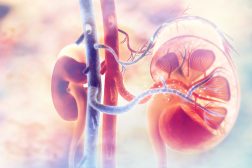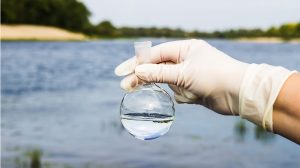Table of Contents
Definition
noun
plural: mononucleotides
mon·o·nu·cle·o·tide, ˌmɒnəʊˈnjuːklɪəˌtaɪd
A single nucleotide (as opposed to other types, such as dinucleotide and trinucleotide, characterized by being an organic compound made up of a nucleobase, a sugar, and a phosphate group
Details
Overview
A nucleotide is regarded as the basic building block of nucleic acid polymers (e.g. DNA and RNA). It is an organic compound made up of three subunits: a nucleobase (either a purine or a pyrimidine), a five-carbon sugar (pentose), and a phosphate group. The sugar component may either be ribose or deoxyribose. The ribose sugar is the sugar component of the nucleotides that make up RNA. The deoxyribose sugar is the sugar component of DNA. Each phosphate group connects the sugar rings of two adjacent nucleotide monomers. The phosphate groups and the sugar moieties form the backbone of a nucleic acid. The directionality of the chain runs from 5′-end to 3′-end. In DNA, the orientation of the two strands is in opposite directions. This is to allow complementary base pairing between nucleobase constituents. Apart from the long chain of nucleic acids, nucleotides also occur in cyclic forms. Cyclic nucleotides form when the phosphate group is linked twice to the sugar moiety, particularly to the two hydroxyl groups of the constituent sugar.
The fundamental nucleotides are divided into purines and pyrimidines. In DNA, the purine bases are commonly adenine and guanine whereas the pyrimidine bases are typically thymine and cytosine. RNA includes adenine, guanine, cytosine, and uracil instead of thymine. The difference between uracil and thymine is the presence of methyl in thymine.
While both purines and pyrimidines are heterocyclic aromatic compounds, they can be differed from each other based on the chemical structure. A purine has two carbon rings whereas a pyrimidine has one carbon ring. The purine has a pyrimidine ring fused to an imidazole ring. The pyrimidine has only a pyrimidine ring. Thus, the purine has four nitrogen atoms whereas the pyrimidine has two.
Types
Nucleotides may be grouped into mononucleotides, dinucleotides, and trinucleotides. A mononucleotide is a single nucleotide. Therefore, it is a single unit comprised of one nucleobase, one pentose moiety, and phosphoric acid. Flavin mononucleotide (FMN) (chemical formula: C17H21N4O9P) is an example of a mononucleotide. It is also known as riboflavin-5′-phosphate. It is a biomolecule derived from vitamin B2 (riboflavin) through the catalytic activity of the enzyme riboflavin kinase. In essence, a phosphorylated vitamin B2 is FMN. Some of the biochemical pathways that this biomolecule is associated with include vitamin B6 metabolism, riboflavin metabolism, pyrimidine metabolism, beta-alanine metabolism, arginine and proline metabolism, and pantothenate and coA biosynthesis.
Biological functions
Aside from serving as precursors of nucleic acids, mononucleotides also serve as important cofactors. For example, FMN is a mononucleotide acts as a cofactor. In particular, it assists certain oxidoreductases (e.g. NADH dehydrogenase) in various oxidation-reduction reactions. It is also functions as a cofactor in blue-light photo receptors. FMN may be converted to flavin adenine dinucleotide (FAD), a dinucleotide, through the action of FAD pyrophosphorylase with ATP. FAD, similarly a cofactor in various redox reactions, consists mainly of adenine and flavin mononucleotide joined at their phosphate groups. FMN, when contained in a protein, forms certain flavoproteins. These proteins are essential in many biological processes, such as DNA repair, bioluminescence, photosynthesis, and the removal of free radicals.
Supplementary
Etymology
- mono– (“single”) + nucleo– (“nucleus“) + –ide (chemical suffix)
Derived term(s)
Further reading
See also
- nucleotide
- dinucleotide
- trinucleotide
© Biology Online. Content provided and moderated by Biology Online Editors







